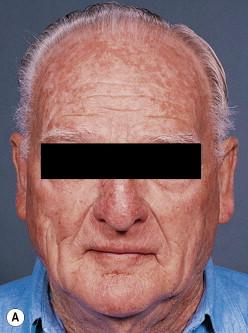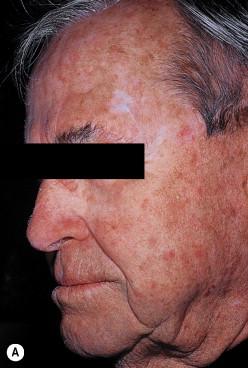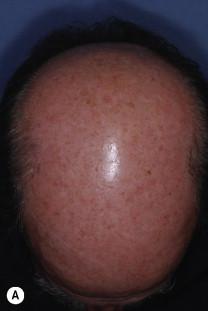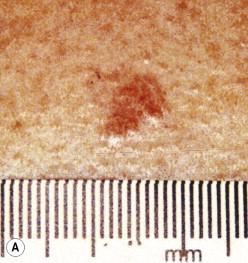Physical Address
304 North Cardinal St.
Dorchester Center, MA 02124
DNA analogs are effective in treating actinic keratoses.
Immune response modifiers are effective in treating actinic keratoses, squamous cell carcinoma and basal cell carcinoma through immunomodulation.
Inhibition of cyclo-oxygenase enzymes is effective in ablating actinic keratoses.
Other compounds are being evaluated for their therapeutic effects as topical chemotherapeutic agents against skin cancer.
Topical chemotherapy combined with physical modalities may be the most effective approach by combining the benefits of field and lesional therapy.
Cancer chemotherapy ideally produces selective destruction of the malignant or abnormal cells with minimal or no toxicity to normal cells. The application of topical chemotherapy for the treatment of actinic keratoses (AKs) and non-melanoma skin cancers (NMSCs) attempts to achieve this without the associated risks of systemic chemotherapy and is gaining increased recognition. Over the past decade, there have been many exciting new topical therapeutic modalities as well as modifications of existing treatments which represent significant advances.
AKs represent the initial manifestation of abnormal keratinocyte proliferation with the potential of progression to invasive squamous cell carcinoma (SCC). When present in limited numbers, traditional lesion-targeted AK therapies such as cryotherapy and curettage may be appropriate. However, contemporary research supports the idea of ‘field cancerization’, indicating that each visible lesion may be surrounded by a zone of photodamage where subclinical AKs can be present 10-fold more frequently than visible AKs. Thus, topical treatment offers the opportunity to treat visible AKs while simultaneously preventing the progression of subclinical lesions. Additionally, topical chemotherapeutic agents offer the potential advantage of selectively eliminating various types of abnormal epithelial and even dermal cells with minimal toxicity to normal skin cells.
Factors to consider in choosing a topical chemotherapy agent for treating skin cancer include expected intensity of local reaction, absorption, potential for systemic side effects, efficacy, application frequency and treatment duration, potential for allergic contact dermatitis, and confounding patient factors. The confounding factors, such as the presence of an implanted pacemaker or the existence of severe thrombocytopenia, often make topical therapy an attractive option compared to surgical intervention. Nonetheless, the practitioner must readily acknowledge the single most common criticism of topical therapy, namely that it is a ‘blind’ procedure, unaccompanied by the inherent ability to verify diagnosis and/or check for tumor-free margins in a tissue specimen. Thus, the patient benefit must outweigh any risk when choosing to employ topical therapy as the definitive treatment of cutaneous neoplasia.
In evaluating the efficacy of topical agents, it must be understood that optimum endpoints are uncertain and that clinical studies are rarely comparable. What should be the gold standard in this regard? Should it be percentage reduction in lesions (when multiple are present, such as in AK) or absolute clearance of the treated field? If absolute clearance is selected, should this reflect clearance of initially detectable lesions only or clearance of both initial and subsequently revealed lesions? Should clinical clearance be verified by one or more test-of-cure biopsies? At what point in time should efficacy be assessed? Are long-term studies (1 year to 5 years) the most appropriate? Until the answers to these and other questions are definitively determined, the practitioner must interpret the published data in light of experience and evolving standards of care. The advantages and disadvantages of using various topical therapeutic modalities compared to surgical interventions are summarized for treating skin cancer in Table 43.1 , and the current indications for specific topical chemotherapy are listed in Table 43.2 .
| Advantages | Disadvantages | |
|---|---|---|
| Topical | ||
| 5-fluorouracil |
|
|
| Imiquimod |
|
|
| Diclofenac |
|
|
| Photodynamic therapy |
|
|
| Retinoids |
|
|
| Colchicine |
|
|
| Surgical | ||
| Cryotherapy |
|
|
| Excision |
|
|
| Skin Lesion | 5% 5-FU | 0.5–2% 5-FU | Imiq 5% | Resiq | Diclofenac | PDT | Retinoids | Bexarotene | Colchicine | NM | T4 |
|---|---|---|---|---|---|---|---|---|---|---|---|
| AKs | |
|
|
|
|
|
|
|
|
||
| SBCC | |
|
|
|
|
||||||
| NBCC | |
|
|
||||||||
| IBCC | |
||||||||||
| SCCIS | |
|
|
|
|||||||
| BP | |
|
|||||||||
| CIN/ VIN | |
|
|||||||||
| ISCC | |
||||||||||
| CTCL | |
|
|
|
|
||||||
| KS | |
|
|||||||||
| LMM | |
||||||||||
| EMPD | |
||||||||||
| OL | |
||||||||||
| VN | |
FDA-approved treatment indication.
Topical 5-fluorouracil (5-FU) is a well-established topical agent commonly used to treat patients with a large number of AKs. As an antimetabolite of uracil, 5-FU blocks the conversion of uridine monophosphate to thymidine monophosphate, impairing the synthesis of DNA and RNA, most prominently in abnormal keratinocytes. In the 1960s, cancer patients undergoing systemic treatment with 5-FU were discovered to experience an inflammatory reaction at sites of AKs followed by subsequent resolution of lesions. This observation led to the initiation of topical 5-FU for AK management. 5-FU remains a first-line treatment of AKs and has been also approved for the treatment of superficial basal cell carcinoma (sBCC). The agent is neither approved nor recommended for the treatment of nodular or other morphologic forms of invasive basal cell carcinoma.
Topical 5-FU preferentially interacts with rapidly proliferating keratinocytes, creating an intense inflammatory reaction leading to cell death with relative sparing of surrounding normal skin. Visible actinic lesions are targeted, as well as subclinical AKs in surrounding areas of photodamaged skin. As a result, topical 5-FU therapy reduces the rate of local recurrence and subsequent development of primary malignancy compared with lesion-directed therapies that treat only clinically visible lesions.
The standard treatment regimen for AKs is twice-daily application of 1–5% 5-FU cream or solution to the involved areas for 2–4 weeks or until a significant inflammatory reaction is achieved, at which point treatment is discontinued ( Fig. 43.1 ). No difference in efficacy has been found between the 1%, 2% and 5% preparations. More recently, a 0.5% microsphere cream formulation was approved by the United States Food and Drug Administration (FDA) for once-daily treatment of AKs of the face and anterior scalp. Studies have shown an overall 89% reduction of AKs and a complete clearance rate of 48% in patients receiving once-daily application of the 0.5% microsphere cream for 4 weeks ( Fig. 43.2 ).


A single-blind, randomized, split-face study compared the efficacy of 5-FU 0.5% microsphere cream and 5-FU 5% cream, each being applied once daily for 4 weeks. Both agents achieved a complete lesion clearance rate of 43% at 4 weeks post-therapy. Although both formulations can induce varying levels of inflammation, most patients preferred the 0.5% cream due to the convenience of once-daily dosing (compared to the recommended twice-daily application of the 5% cream), and a perception of less irritation. A recent comparative study suggested the 0.5% cream is equally efficacious to the 5% but may be more cost- effective, safer and better tolerated.
Askew et al. conducted a systematic review of randomized controlled trials to determine the effectiveness of 5-FU treatment for AKs. An average of 49% of patients treated with 5% 5-FU and 35% treated with 0.5% 5-FU achieved complete clearance. Both formulations led to an approximately 80% reduction in lesion counts. However, over 60% of patients required re-treatment after 1 year for recurrences. 5-FU is quite effective for AKs on the head and neck region but treatment is less effective for extremity AKs and hyperkeratotic AKs.
Superficial BCC has been successfully treated with 5-FU. However, current published data only support the use of the higher-strength (5%) formulation. Application should be twice daily to cover the lesion plus a several-millimeter margin. The approved length of treatment is 3–6 weeks, but based on more recent studies, up to 11 weeks may be needed to completely clear lesions. Gross et al. demonstrated a 90% clearance rate by histology on the basis of 3-week follow-up of 31 patients treated with twice-daily 5% 5-FU therapy. More recently, a 90% cure rate for moderate-thickness BCCs was achieved by combining 5-FU with phosphatidylcholine as a transepidermal carrier. Concerns have also been raised that only the superficial components of BCCs might be treated with 5-FU, leading to persistence of the deeper aspects of the tumor.
A recent systematic review compared five studies demonstrating the efficacy of topical 5-FU for the treatment of SCC in situ (SCCIS). Unfortunately, dosing schedules and lengths of treatment varied widely in these studies. A clinical clearance rate of 48–56% was achieved at 12-month follow-up after daily dosing for 1 week followed by twice-daily dosing for 3 weeks. An 85% clinical clearance rate was achieved after a more intense regimen of twice-daily dosing for 8 weeks with an average follow-up of 4.6 years.
The British Association of Dermatologists' 2006 guidelines for the management of SCCIS recommended once- or twice-daily application of 5% 5-FU cream for up to 2 months, with repeat treatment cycles as needed. SCCIS (Bowen's disease) of the penis can be similarly treated with 5% 5-FU twice daily for 4–5 weeks; accompanying inflammation may however limit tolerability and therefore impair patient compliance with an adequate treatment regimen. Increased efficacy has been achieved for SCCIS when administered under occlusion, or with the concurrent use of dinitrochlorobenzene, iontophoresis, or erbium:YAG laser.
The usual treatment for extramammary Paget's disease is radical local excision. While there is very limited data proposing that topical 5-FU can substitute for surgical intervention, the agent can be utilized, via short-term pre-operative application, to expose clinically invisible foci of this often multifocal disorder. This maneuver may help to better ensure adequate surgical excision.
The treatment of choice for keratoacanthomas is surgical extirpation. In selected cases, however, topical 5-FU may be of benefit. The agent can be used as an adjunct to laser ablation or as a primary intervention in the specific subtype: keratoacanthoma centrifugum marginatum. A small, clinically classic keratoacanthoma in a low-risk anatomic area may also be managed with topical 5-FU. In this situation, a therapeutic trial should be limited to 3 weeks.
In all cases of SCC and BCC treated with 5-FU, careful follow-up is needed to ensure cure. Inadequate treatment may resolve only the superficial component and render the diagnosis of recurrence more difficult. Due to the small sample size of most studies and relative lack of long-term follow-up, Love et al. concluded that its use should be limited to small areas of SCCIS in low-risk areas (trunk, extremities and neck) or multiple areas of superficial BCCs in difficult-to-treat areas. 5-FU may also be used in patients unable to tolerate other treatment.
The most common limitation of 5-FU therapy is the development of intense local inflammation associated with pain, erythema, erosion, ulceration and crusting. To help increase compliance, some practitioners have tried weekly pulsed dosing for longer durations. This method causes less local irritation but has not proven to be reliably effective at resolving AK lesions. An inflammatory response appears to be necessary for efficacy in 5-FU treatment, and patients with the most intense reactions often achieve the best clinical responses.
A high level of compliance is required to achieve a successful treatment outcome with 5-FU therapy. Patients need to be forewarned about the expected inflammatory reaction. Upon completion of the course of topical 5-FU therapy, mid-potency topical corticosteroids can be applied to the zone of inflammation to help hasten healing. Patients should be instructed to avoid application of 5-FU on mucous membranes, as well as on uninvolved periorbital, intertriginous, and genital areas, to avoid significant inflammation in these sensitive regions.
Systemic reactions related to topical application of 5-FU appear to be rare. Less than 10% of a dose of 5-FU 5% cream applied topically to intact skin is reported to be absorbed systemically. Urinary excretion of 5-FU after application of 5-FU 0.5% microsponge cream was one-fortieth of that observed with 5-FU 5% cream despite only a one-tenth difference in drug concentration. Systemic absorption of 5-FU may be significantly increased in patients with dihydropyrimidine dehydrogenase (DPD) deficiency because of an impaired ability to metabolize 5-FU. These patients are at risk of severe toxicity and the use of 5-FU is contraindicated in those with known DPD deficiency. Routine testing for this deficiency, however, is not standard of care.
Imiquimod is a synthetic imidazoquinolone that functions as an immune response modulator with antiviral and antitumor activity for the treatment of skin cancer (see Chapter 44 ). Imiquimod's activity is mediated through Toll-like receptor (TLR) 7 and 8 signaling, resulting in secretion of pro-inflammatory cytokines (including interferons alpha and gamma, TNF alpha, IL-1, IL-6, IL-8, IL-10 and IL-12) that stimulate a localized cellular immune response against abnormal epithelial cells.
Imiquimod was originally approved as a 5% cream for the treatment of external genital warts and has subsequently been approved for the treatment of non-hypertrophic AKs on the face and scalp and superficial BCCs. In the United States, the 5% imiquimod preparation is approved for AKs in a regimen of twice-weekly application for 16 weeks. However, imiquimod is also typically used for treating AKs with once-daily application two to three times per week for 4 weeks, followed by a second 4-week treatment cycle if lesions have not resolved. While increased frequency of dosing has been shown to achieve a superior response, this is accompanied by increased adverse effects. Gebauer et al. found that application of 5% imiquimod more than three times a week was not well tolerated and led to a 33% clinical study withdrawal rate.
In a retrospective review of 5% imiquimod topical therapy for AKs, Gaspari et al. reported overall complete clearance rates ranging from 45% to 57% and a median AK reduction rate of about 80%. A systematic review of 1293 AK patients largely confirmed this, with 50% of patients treated for 12–16 weeks with imiquimod achieving complete clinical clearance. In a head-to-head comparison with topical 5-FU and liquid nitrogen cryosurgery for the treatment of AKs, topical imiquimod demonstrated superior cosmetic outcomes and higher long-term complete clinical clearance rates at 12-month follow-up (73% imiquimod versus 33% 5-FU and 4% cryosurgery). The use of imiquimod in combination with other AK treatment modalities (such as cryosurgery, 5-FU and photodynamic therapy) is evolving.
Because of the long treatment course and counter-intuitive regimen typically required for 5% imiquimod monotherapy in the management AKs, other formulations have recently been studied. A 3.75% formulation is likely optimum, and is utilized as daily application in a 6-week total regimen (2 weeks therapy, 2 weeks rest period, 2 weeks therapy). The 3.75% imiquimod formulation affords comparable clinical efficacy to the 5% cream, with reduced risk of unacceptable local skin reactions, a shorter course of therapy, and an intuitive (daily) application schedule ( Fig. 43.3 ).

Numerous clinical trials and studies have demonstrated the safety and efficacy of imiquimod for the treatment of superficial BCCs. BCCs are typically treated with once-daily application, five times a week for a total of 6 weeks, with a minimum of 3 months follow-up ( Fig. 43.4 ). A systematic review of 515 patients with superficial BCC treated with imiquimod at least daily, 5–7 days a week for 6–12 weeks, demonstrated an overall histologically confirmed clearance rate of 81% at 6 or 12 weeks. A phase III study investigated the long-term efficacy of treatment: after application of imiquimod five times a week for 6 weeks to superficial BCC less than 2 cm, cure rates at 1- and 2-year follow-up were 90.4% and 82%. Gollnick et al. demonstrated that after 6 weeks' application of 5% imiquimod for 5 days a week, a post-treatment clearance rate of 90.3% after 12 weeks and a sustained clearance rate of 80.9% after 5 years could be achieved. All recurrences occurred within 12 months, suggesting that assessment of initial response may be valuable for predicting the long-term outcome of patients treated with imiquimod for sBCCs.

Several studies indicate that imiquimod may also be effective for nodular BCCs. However, effective treatment requires higher dosages and lower clearance rates are achieved compared to procedural modalities. The largest study of 167 patients (including only low-risk BCCs: less than 2 cm in size, greater than 1 cm from the eyes, nose, mouth, ears, or hairline and excluding infiltrating morpheic and micronodular histologic patterns) found a 76% histologic clearance rate at 6 weeks after daily imiquimod for 12 weeks compared with a 42% histologic clearance rate for twice-daily imiquimod, 3 days a week for 6 weeks. In a more recent report, an initial clearance rate of 78% was achieved. However, 17% of these patients subsequently had histologic evidence of residual disease, which raised concern that an excisional biopsy may be needed to confirm complete clearance of nodular BCCs, thereby defeating the purpose of topical therapy. Debulking the tumor with curettage prior to imiquimod therapy enhances the cure rate.
There is growing evidence that imiquimod may be useful in the treatment of infiltrative BCC, SCCIS, and, to a lesser degree, invasive SCC. Vidal et al. demonstrated a sustained 5-year clearance rate of 60% for infiltrative BCC after imiquimod therapy. To date, five studies have investigated the use of imiquimod for SCCIS. Clearance rates ranging from 73% to 88% have been achieved after daily application (or every-other-day dosing with genital lesions) for 9–16 weeks. Tumors confined to the trunk or upper extremities had higher clearance rates compared with large facial and lower leg lesions. Pooled analysis of randomized controlled trials, uncontrolled and cohort studies, demonstrated mean clearance rates of 51%, 70% and 48% for vulvar intraepithelial neoplasia, penile intraepithelial neoplasia and anal intraepithelial neoplasia, respectively. One study attempted treatment of invasive SCC with imiquimod 5 days per week for 12 weeks and achieved a 71% histological clearance rate at 28-month follow-up. Scattered case reports also document the efficacy of imiquimod for invasive SCC.
Due to limited evidence of sustained 5-year clearance rates, recent systematic reviews cautioned against the use of imiquimod monotherapy in the treatment of non-superficial BCC or invasive SCC. Studies suggest limiting this approach for treating these lesions to tumors less than 2 cm in diameter, located in low-risk anatomic locations, and in patients who cannot tolerate or who refuse other well-established treatments. A recent retrospective study revealed significantly lower clearance rates in patients with high-risk mixed aggressive BCC, nodular BCC, and SCCIS. Significant cutaneous or systemic comorbidities were also reported as risk factors for a worse prognosis.
Several reports support the use of imiquimod for the treatment of rapidly appearing, multiple BCCs in basal cell nevus syndrome (BCNS), xeroderma pigmentosa (XP) or in immunosuppressed transplant patients. However, the use of imiquimod as ongoing or intermittent topical prophylaxis to prevent NMSC associated with the high-risk conditions noted above has not yet become a widely accepted practice.
Imiquimod has been used in the treatment of lentigo maligna melanoma. A comprehensive post-hoc review of five studies found complete histologic clearance in 67–100% of patients treated with 5% imiquimod daily for 6–13 weeks, with one trial demonstrating no relapses at 1-year follow-up. Currently, it is suggested that imiquimod only be used in a very narrow scope for lentigo maligna melanoma, such as treatment of post-excision recurrences or for adjunct management of poor surgical candidates or inoperable tumors.
Imiquimod's ability to induce local release of interferon-alpha led to the investigation of its use as a treatment for Kaposi sarcoma (KS). In an open-label trial, 17 patients with classic KS were treated with imiquimod under occlusion three times a week for 24 weeks. Two complete responses and six partial responses were reported. Imiquimod may therefore serve as a viable treatment option for cutaneous KS in patients who are unsuitable for more aggressive therapy.
Imiquimod has also been reported to successfully treat other forms of cutaneous malignancies, including patch stage cutaneous T-cell lymphoma (CTCL) and extramammary Paget's disease. Based on in-vitro evidence of anti-angiogenic properties, imiquimod has also been used to treat vascular neoplasms, including hemangiomas of infancy, pyogenic granulomas and congenital port-wine stains. The optimum dosing regimen is unknown for all of the aforementioned conditions, and sufficient long-term follow-up is also lacking.
A recent multicenter, placebo-controlled safety and efficacy study performed by the Skin Care in Organ-transplant Patients, Europe (SCOPE) research network enrolled 43 patients in six European transplant centers. Among patients randomized to imiquimod, the histologically confirmed complete clearance rate was 62%, compared to a complete clearance rate of 0% in the vehicle group. In order to exclude graft rejections induced through the Th1 immune response of the immune response modifier (IRM) imiquimod, all patients were monitored for changes in hematology and serum chemistry. In all studies published to date with imiquimod in organ transplant recipients (OTR), no adverse effect of the IRM on the function of the graft has been observed.
Patients should be informed about common local application site reactions with imiquimod therapy, which are largely secondary to the inflammatory response, including erythema, crusting, flaking, erosion and ulceration, edema, and oozing or weeping. If these develop in excess, treatment can be suspended for a few days without an apparent decrease in efficacy. However, local inflammation appears to correlate with success, so patients should be informed that some degree of inflammation is desirable to achieve the best results. Rivers et al. demonstrated that 4-week rest periods between 4-week treatment cycles for AKs decreased local skin reactions without decreasing overall efficacy of 5% topical imiquimod.
The effects of imiquimod are generally localized to the skin, with minimal systemic absorption. Systemic side effects can include flu-like symptoms, experienced by fewer than 10% of patients. Overall cosmetic results are favorable, with rare reports of mild residual hyperpigmentation or hypopigmentation.
Resiquimod is another imidazoquinolamine which has currently only completed phase II studies for the treatment of AKs. Similar to imiquimod, it is a TLR-7 and TLR-8 agonist; however, it is purported to be 10 to 100 times more potent and has the ability to stimulate a greater spectrum of inflammatory cytokines. Limited studies indicate that resiquimod 0.01% gel can be used three times a week for 4 weeks to face and scalp AKs to achieve a 77% overall clearance rate. After a single 4-week treatment course, resiquimod achieves a clearance rate comparable to the rate imiquimod attains after two courses of treatment. However, resiquimod concentrations of 0.03% and higher lead to severe local erythema, inflammation, and increased systemic side effects that are not well tolerated. Further investigation is needed to determine if resiquimod can offer a greater risk-to-benefit profile for the treatment of advanced NMSCs. Sotirimod is an additional drug in this class which might have clinical utility.
Become a Clinical Tree membership for Full access and enjoy Unlimited articles
If you are a member. Log in here